To brew the perfect eco-friendly green tea, aim for a temperature between 160°F to 180°F (71°C to 82°C). You'll want to steep for 1-3 minutes, adjusting based on leaf size and personal taste. Consider energy-efficient methods like cold brewing or using solar-powered kettles. Opt for sustainable tea kettles with smart temperature controls to minimize energy waste. Use filtered water and measure carefully to conserve resources. Don't forget to reuse your tea leaves for multiple infusions and compost them afterward. By mastering these techniques, you'll not only enjoy a delicious cup but also reduce your environmental impact. Discover how small adjustments can lead to big improvements in your tea experience.
Optimal Temperature for Green Tea

Precision is key when brewing the perfect cup of green tea. The best temperature for green tea typically ranges between 160°F and 180°F (71°C to 82°C). This lower temperature range, compared to other teas, helps preserve the delicate flavors and prevents bitterness.
For most green teas, aim for 175°F (79°C). However, some varieties benefit from slightly different temperatures. Japanese green teas like Sencha and Gyokuro prefer cooler water, around 160°F (71°C), to maintain their subtle, grassy notes. Chinese green teas, such as Longjing or Gunpowder, can handle slightly hotter water, up to 180°F (82°C).
To achieve the ideal temperature without a thermometer, try these methods:
- Let boiling water cool for 2-3 minutes before pouring.
- Add a splash of cold water to boiling water.
- Use the "shrimp eyes" method: Look for tiny bubbles forming at the bottom of the kettle, resembling shrimp eyes.
Energy-Efficient Brewing Methods
You can reduce your energy consumption while brewing green tea by exploring eco-friendly methods.
Consider cold brewing your tea overnight in the refrigerator, or invest in a solar-powered kettle for daytime brewing.
Using insulated steeping containers will help maintain ideal temperatures without additional energy input, making your green tea routine more environmentally friendly.
Cold Brew Overnight
The gentle art of cold brewing offers a revitalizing and energy-efficient method for preparing green tea. To cold brew overnight, you'll need a large jar, room temperature water, and your favorite green tea leaves.
Simply add 1-2 teaspoons of tea leaves per cup of water to the jar, seal it, and let it steep in the refrigerator for 6-8 hours or overnight. This method requires no heat, saving energy and preserving the tea's delicate flavors and beneficial compounds.
You'll notice a smoother, less bitter taste compared to hot-brewed green tea. Cold brewing also results in lower caffeine content, making it an excellent option for those sensitive to caffeine or looking for a rejuvenating evening drink.
When your tea is ready, strain the leaves and enjoy it over ice or at room temperature. You can store the cold brew in the refrigerator for up to 3 days, allowing you to make larger batches and save time.
Experiment with different steeping times and tea-to-water ratios to find your perfect balance of flavor and strength. Cold brewing is an eco-friendly and convenient way to enjoy green tea year-round.
Solar-Powered Kettle Options
Harnessing the sun's power for your tea-brewing needs is an innovative approach to eco-friendly green tea preparation. Solar-powered kettles offer a sustainable alternative to traditional electric models, reducing your carbon footprint while still enjoying perfectly brewed tea.
These kettles come in various designs, from portable camping options to sleek home appliances. They typically use photovoltaic panels to convert sunlight into electricity, which then heats the water. While they may take longer to boil water compared to conventional kettles, they're ideal for outdoor use or in areas with limited access to electricity.
Here's a comparison of popular solar-powered kettle options:
| Model | Capacity | Boiling Time | Portability |
|---|---|---|---|
| SunKettle | 500ml | 30-60 mins | High |
| GoSun Brew | 400ml | 20-45 mins | Medium |
| SolSource Sport | 1L | 10-30 mins | Low |
| Sun Teas Kettle | 750ml | 40-70 mins | High |
When choosing a solar-powered kettle, consider factors like capacity, boiling time, and portability. While these eco-friendly options may require more patience, they offer a sustainable way to enjoy your green tea while reducing your environmental impact.
Insulated Steeping Containers
While solar-powered kettles offer an eco-friendly heating solution, insulated steeping containers provide an energy-efficient method for brewing green tea.
These containers maintain the water's temperature for extended periods, allowing you to steep multiple cups without reheating. By using an insulated container, you'll conserve energy and guarantee consistent brewing temperatures throughout your tea-drinking session.
Choose a high-quality insulated container made from sustainable materials like stainless steel or bamboo. Fill it with water heated to the ideal green tea temperature (160-180°F) and add your tea leaves. The insulation will keep the water at the perfect steeping temperature, resulting in a delicious and eco-friendly brew.
Here are some benefits of using insulated steeping containers:
- Maintains ideal brewing temperature for longer
- Reduces energy consumption by eliminating the need for reheating
- Allows for multiple infusions from the same leaves
- Portable for on-the-go tea brewing
- Often made from durable, recyclable materials
Sustainable Tea Kettles
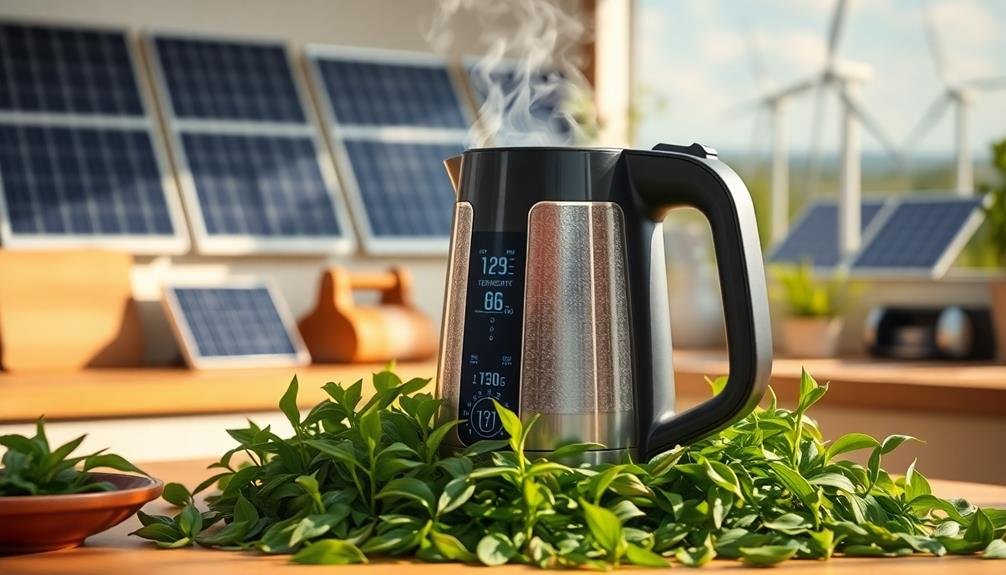
When choosing a sustainable tea kettle, you'll want to contemplate energy-efficient options that minimize electricity usage.
Look for kettles made from durable materials like stainless steel or glass, which can last for years and reduce waste.
Smart temperature controls can help you achieve the perfect brewing temperature for your green tea while conserving energy.
Energy-Efficient Kettle Options
Your kettle choice plays an essential role in making eco-friendly green tea. When selecting an energy-efficient kettle, consider options that offer precise temperature control, rapid heating, and automatic shut-off features. These elements not only save energy but also guarantee you're brewing your green tea at the ideal temperature.
Look for kettles with:
- Variable temperature settings
- Insulated double-wall construction
- Boil-dry protection
- Energy-efficient LED indicators
- Low-wattage heating elements
Electric kettles are generally more energy-efficient than stovetop models, as they heat water directly and lose less heat in the process. Opt for kettles with a capacity that matches your typical usage to avoid overheating excess water.
Some modern kettles even come with smart features, allowing you to control them remotely via smartphone apps, further enhancing your energy consumption.
Consider investing in a kettle made from sustainable materials like bamboo or recycled plastics. These eco-friendly options not only reduce your carbon footprint but also add a touch of style to your kitchen.
Durable Materials Matter
In line with eco-friendly practices, the materials used in your tea kettle's construction play an essential role in its sustainability. When choosing a kettle for your green tea, opt for durable materials that'll stand the test of time. Stainless steel is an excellent choice, as it's long-lasting, recyclable, and doesn't leach harmful chemicals into your tea. Glass kettles are another eco-friendly option, allowing you to see the water boiling without using excess energy.
Avoid kettles made from plastic, as they're less durable and may contain harmful chemicals. Instead, look for kettles made from bamboo, copper, or cast iron. These materials not only last longer but also add a unique aesthetic to your tea-making experience.
| Material | Durability | Eco-Impact |
|---|---|---|
| Stainless Steel | High | Low |
| Glass | Medium | Low |
| Copper | High | Medium |
Smart Temperature Controls
Beyond durable materials, smart temperature controls are the next step in sustainable tea kettles. These innovative features help you brew the perfect cup of green tea while minimizing energy waste. By precisely controlling the water temperature, you'll avoid overheating and guarantee peak flavor extraction.
Smart kettles offer various benefits for eco-conscious tea enthusiasts:
- Precise temperature settings for different tea types
- Automatic shut-off to prevent energy waste
- Keep-warm functions that maintain temperature efficiently
- Energy-saving modes for standby periods
- Integration with smart home systems for remote control
You'll find that these advanced temperature controls not only improve your tea-brewing experience but also reduce your carbon footprint. Many models allow you to set exact temperatures, guaranteeing you don't waste energy heating water beyond what's necessary for green tea (typically 160-180°F).
When shopping for a smart kettle, look for ones with clear temperature displays and easy-to-use controls. Some even come with preset options for different tea varieties, taking the guesswork out of brewing.
Water Quality and Conservation
While brewing the perfect cup of green tea is crucial, the quality of water you use plays an important role in both taste and sustainability. Opt for filtered water to remove impurities that can alter the tea's flavor and aroma. If you're using tap water, let it run for a few seconds to verify it's fresh and free from any stagnant pipes.
To conserve water, avoid overfilling your kettle. Measure only the amount you need for your tea, which not only saves water but also energy. Consider collecting and reusing any excess water for watering plants or cleaning.
When it comes to tea leaves, choose organic options to support sustainable farming practices. After brewing, don't discard used tea leaves. They're excellent for composting or as a natural fertilizer for your garden.
If you're using tea bags, opt for biodegradable ones without plastic components. Better yet, switch to loose-leaf tea to reduce packaging waste.
Steeping Time and Flavor Balance
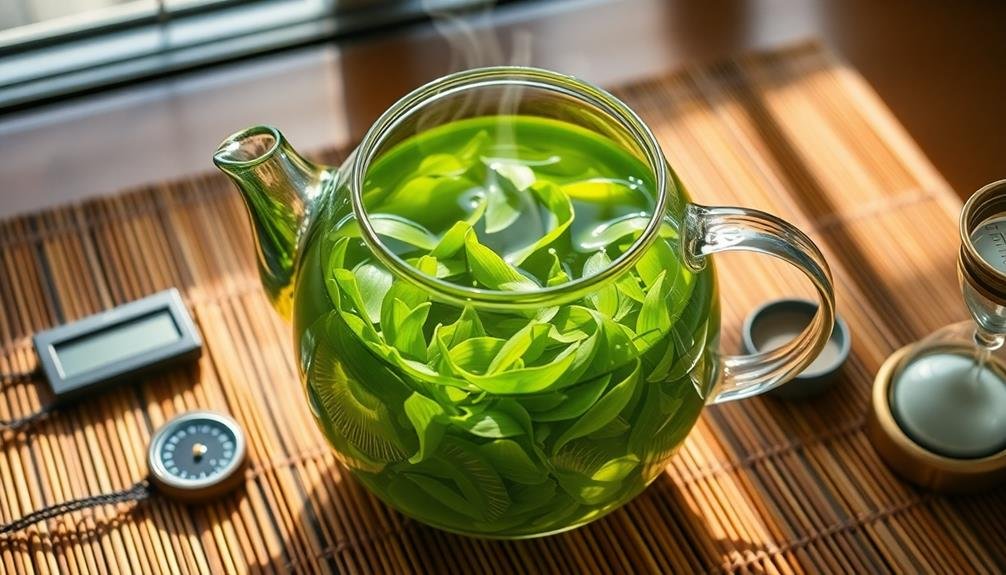
Steeping time substantially impacts the flavor balance of your green tea. To achieve the perfect cup, you'll need to take into account the type of green tea you're brewing and your personal taste preferences. Generally, green tea requires a shorter steeping time than other tea varieties, typically between 1 to 3 minutes.
Steeping for too long can result in a bitter, astringent taste, while under-steeping may produce a weak, flavorless brew.
To help you find the ideal steeping time for your green tea, take into account these factors:
- Tea leaf size: Smaller leaves infuse faster than larger ones
- Water temperature: Higher temperatures extract flavors more quickly
- Desired strength: Longer steeping times produce stronger flavors
- Tea quality: Higher-grade teas often require shorter steeping times
- Personal preference: Experiment to find your perfect balance
Start with the recommended steeping time on the package, then adjust as needed. You can always add more steeping time, but you can't undo over-steeping.
Reusing Tea Leaves Responsibly
Sustainability enthusiasts will be pleased to know that green tea leaves can often be reused for multiple infusions. This practice not only reduces waste but also allows you to enjoy different flavor profiles from the same leaves.
To reuse your tea leaves responsibly, start by storing them properly between infusions. After your first brew, gently remove the leaves from your teapot or infuser and place them in a clean, dry container. Keep them in a cool, dark place to prevent spoilage.
When you're ready for a second infusion, increase the steeping time by about 30 seconds to one minute to extract the remaining flavors. You can typically reuse green tea leaves two to three times before they lose their taste.
As you progress through infusions, you'll notice subtle changes in flavor, with later brews often being milder and smoother. Pay attention to the color and aroma of your tea to gauge its strength. If the tea becomes too weak or loses its characteristic taste, it's time to compost the leaves.
Composting Spent Tea Leaves

Once you've exhausted your tea leaves' brewing potential, don't toss them in the trash. Instead, compost them to enrich your garden soil and reduce waste.
Tea leaves are nitrogen-rich and break down quickly, making them an excellent addition to your compost bin or pile. They'll help balance the carbon-to-nitrogen ratio, speeding up the decomposition process.
To compost your spent tea leaves effectively:
- Remove any staples or tags from tea bags
- Tear open paper tea bags to expose the leaves
- Spread loose leaves evenly throughout your compost
- Mix them with other organic materials like fruit peels and coffee grounds
- Keep your compost moist but not waterlogged
You can also use tea leaves directly in your garden. Sprinkle them around plants as a natural fertilizer or mix them into potting soil.
They'll improve soil structure, retain moisture, and deter pests. If you're growing acid-loving plants like rhododendrons or blueberries, green tea leaves are particularly beneficial due to their slightly acidic nature.
Eco-Friendly Tea Storage Solutions
Proper storage of your green tea is essential for maintaining its quality and reducing waste. Choose airtight containers made from sustainable materials like glass, bamboo, or recycled plastic to keep your tea fresh and flavorful. These containers protect your tea from moisture, light, and air, which can degrade its quality over time.
Store your tea in a cool, dark place away from strong odors and heat sources. Avoid storing it in the refrigerator, as the moisture can affect the tea's taste and aroma. Instead, opt for a pantry or cupboard where the temperature remains relatively constant.
Consider using reusable tea bags or infusers made from organic cotton or stainless steel to reduce single-use waste. These eco-friendly alternatives are durable and can be easily cleaned for repeated use.
Label your tea containers with the purchase date to guarantee you use older teas first, minimizing waste. If you have excess tea, share it with friends or use it in cooking recipes to prevent it from going stale.
Frequently Asked Questions
How Does Altitude Affect Green Tea Brewing Temperature?
As you brew green tea at higher altitudes, you'll need to increase the water temperature. This is because water boils at lower temperatures in high-elevation areas, so you'll need hotter water to extract the tea's flavors effectively.
Can I Use a Microwave to Heat Water for Green Tea?
You can use a microwave to heat water for green tea, but it's not ideal. You'll risk uneven heating and potential overheating. You're better off using a kettle or stovetop for more precise temperature control.
What's the Environmental Impact of Different Tea Packaging Materials?
You'll find that tea packaging materials vary in environmental impact. Loose leaf tea in reusable tins is best. Tea bags made of paper or biodegradable materials are better than plastic ones. Avoid single-use plastic pods for minimal waste.
Are There Eco-Friendly Alternatives to Traditional Tea Bags?
You'll find several eco-friendly alternatives to traditional tea bags. Try using loose leaf tea with reusable infusers, biodegradable tea bags, or even tea leaves wrapped in compostable materials. These options reduce waste and environmental impact.
How Do Different Green Tea Cultivars Affect Optimal Brewing Temperatures?
You'll find that green tea cultivars vary in their ideal brewing temperatures. Some delicate varieties need cooler water, while robust ones can handle higher heat. It's best to experiment and adjust based on the specific cultivar you're using.
In Summary
You've now got the tools to brew the perfect eco-friendly cup of green tea. By paying attention to water temperature, using energy-efficient methods, and choosing sustainable equipment, you're reducing your environmental impact. Don't forget to reuse and compost your tea leaves, and store your tea properly. With these practices, you're not just enjoying a delicious beverage, you're also contributing to a more sustainable world. Keep sipping green and living green!

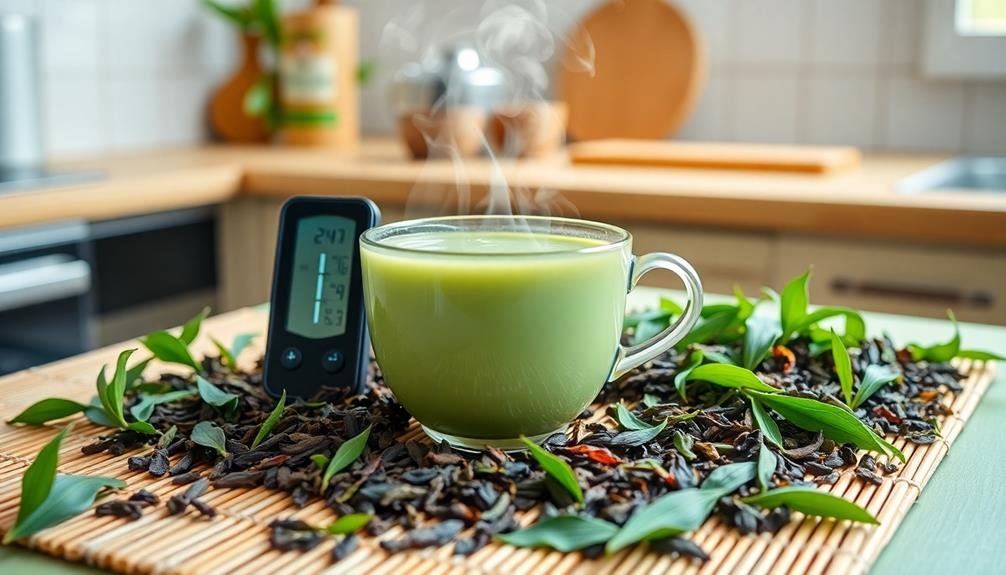
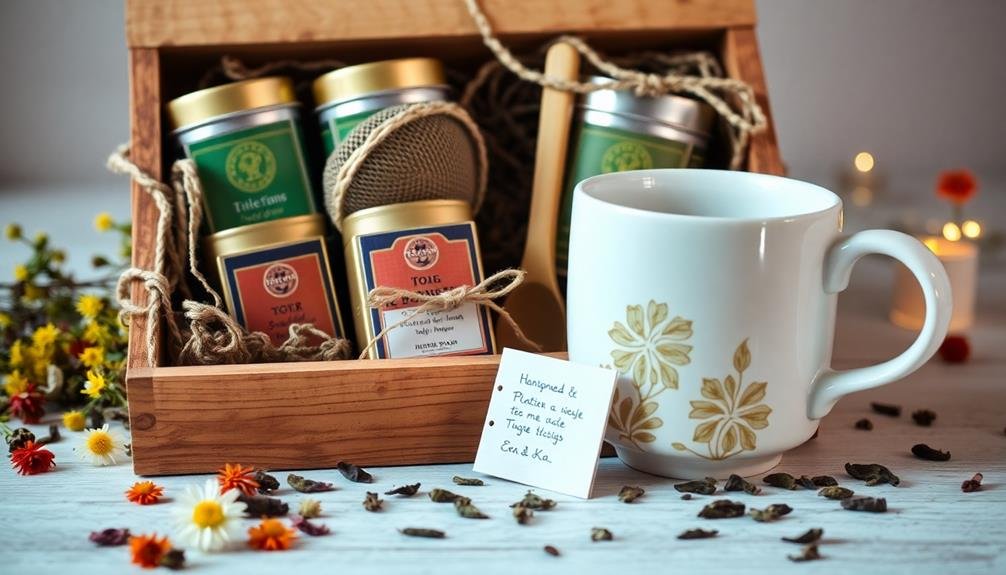

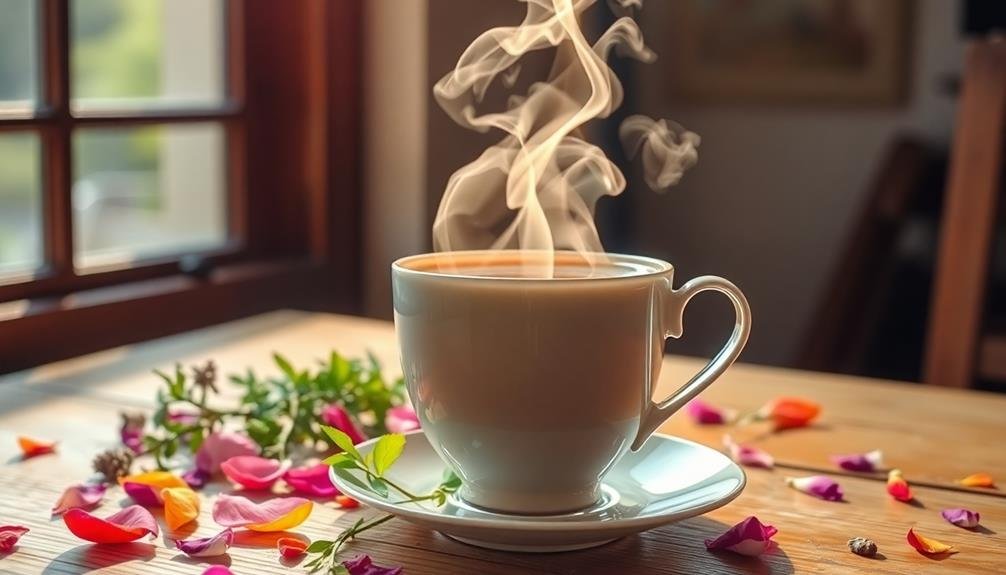
Leave a Reply